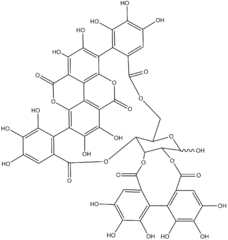Punicalagin
 | |
| Names | |
|---|---|
| Other names
2,3-(S)-hexahydroxydiphenoyl-4,6-(S,S)-gallagyl-D-glucose α-punicalagin β-punicalagin | |
| Identifiers | |
| 65995-63-3 | |
| ChEMBL | ChEMBL506814 |
| Jmol-3D images | Image |
| PubChem | 16129869 |
| |
| Properties | |
| C48H28O30 | |
| Molar mass | 1084.71 g/mol |
| Except where noted otherwise, data is given for materials in their standard state (at 25 °C (77 °F), 100 kPa) | |
| | |
| Infobox references | |
Punicalagin is an ellagitannin, a type of phenolic compounds. It is found in forms alpha and beta in pomegranates (Punica granatum), in Terminalia catappa and Terminalia myriocarpa,[1] and in Combretum molle, the velvet bushwillow, is a plant species found in South Africa.[2] These three genera are all Myrtales and the last two are both Combretaceae.
Health effects
Punicalagins are the largest molecule found intact in rat plasma after oral ingestion[3] and were found to show no toxic effects in rats who were given a 6% diet of punicalagins for 37 days.[4] Punicalagins are also found to be the major component responsible for pomegranate juice's antioxidant activity.[5]
Punicalagin is water soluble and has high bioavailability. They are known to hydrolyze into smaller phenolic compounds such as ellagic acid in vivo where one potential mechanism is hydrolysis across the mitochondrial membrane of cultured human colon cells.[6][7]
It is a highly active carbonic anhydrase inhibitor.[8]
References
- ↑ Marzouk, M. S. A.; El-Toumy, S. A. A.; Moharram, F. A.; Shalaby, N. M.; Ahmed, A. A. (2002). "Pharmacologically Active Ellagitannins from Terminalia myriocarpa". Planta Medica 68 (6): 523–527. doi:10.1055/s-2002-32549. PMID 12094296.
- ↑ Asres, K.; Bucar, F.; Knauder, E.; Yardley, V.; Kendrick, H.; Croft, S. L. (2001). "In vitro antiprotozoal activity of extract and compounds from the stem bark of Combretum molle". Phytotherapy Research 15 (7): 613–617. doi:10.1002/ptr.897. PMID 11746844.
- ↑ Cerda et al. Eur J Nutr. 2003 Jan;42(1), pp. 18-28
- ↑ Cerda et al. J. Agric. Food Chem. 2003, 51, pp. 3493-3501
- ↑ Gil et al. J Agric Food Chem 2000 48 (10), pp. 4581-4589
- ↑ Seeram et al. Clin Chim Acta. 2004 Oct;348(1-2), pp. 63-68
- ↑ Larrosa et al. J Nutr Biochem. 2006 Sep;17(9), pp. 611-625
- ↑ Satomi, H.; Umemura, K.; Ueno, A.; Hatano, T.; Okuda, T.; Noro, T. (1993). "Carbonic anhydrase inhibitors from the pericarps of Punica granatum L". Biological & Pharmaceutical Bulletin 16 (8): 787–790. doi:10.1248/bpb.16.787. PMID 8220326.
| ||||||||||||||||||||||||||||||||||||||
| ||||||||||||||